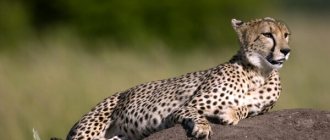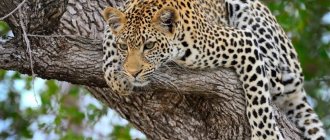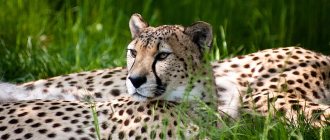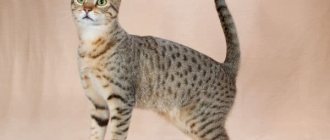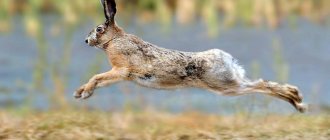Cheetah: UGC The cheetah is one of the fastest predators on the planet. It is capable of reaching speeds of up to 100 km/h. At the same time, he is one of the weakest predators, which is on the verge of extinction. He cannot growl loudly, and his spots are as unique as human fingerprints. Let's tell you more about cheetahs and their way of life.
The cheetah is the fastest animal on Earth. The maximum speed of a cheetah can reach more than 110 km/h. He is able to live for a week without food and 35 years in captivity. However, animals in captivity do not reproduce. Here are the most interesting facts about the cheetah:
There are four subspecies of cheetahs
The Red Book describes such subspecies of cheetahs as:
- South African . Distributed in South Africa, Namibia, Zimbabwe, Botswana, Zambia, Mozambique, Kenya, Tanzania and Uganda. The subspecies known as the Namibian cheetah was first described in the late 18th century by the German naturalist Johann Christian von Schweber. It has existed for more than three million years. Its fur is thicker than that of other subspecies. According to rough estimates, about 7 thousand individuals of this subspecies have survived. Of these, 3.5 thousand live in Namibia.
- Asiatic cheetah. Also known as Iranian or Persian. The subspecies separated from African cheetahs about 30 thousand years ago. The Asiatic cheetah has lighter fur and a short mane compared to its African relatives. The tip of the tail is colored with black stripes. The species was once common in the Arabian Peninsula and throughout the Middle East, but was exterminated by humans. By 2012, about 80 individuals remained in Iran.
- North African cheetah. Also known as the Sudanese cheetah. It was first described in the 50s of the 19th century by the Austrian zoologist Leopold Fitzenger. It has thick yellow-spotted wool, thicker and coarser fur compared to its African relatives. The tail is thick with a white tip. Considered one of the largest cheetahs. According to 2007 data, about a thousand individuals lived in Ethiopia and South Sudan.
- North African cheetah, also known as the Saharan cheetah . Described by the French zoologist Henri-Marie Ducorte de Blainville in 1843. It has short fur, almost completely white. Black and light brown spots are located along the spine and on the legs. The body is smaller than that of its South African relatives. As of 2012, there were slightly more than 450 individuals of this subspecies in the wild.
Photo: pixabay.com: UGC
№13
Just like human fingerprints or zebra stripes, a cheetah's spots are unique. In the wild, it is impossible to meet two individuals with the same set of spots. In total, there are about 2000-3000 inclusions on the animal’s body, which act as camouflage. He especially helps the younger generation.
King cheetah and mutation variants
There is a royal cheetah and various variants of mutations.
Zoologists have found that cheetahs, compared to other cats, have low genetic variability. Therefore, the appearance of the king cheetah seems to be a particularly interesting case for scientists. The animal has cream-colored fur with dark spots and three wide stripes from neck to tail.
The animal was first reported by a certain Major Cooper, who shot an unusual individual in the area of the capital of Zimbabwe, Harare, in 1926. The hunter described the trophy as a cross between a leopard and a cheetah, with fur like a snow leopard.
Thirteen years later, British zoologist Reginald Innes Pocock described the animal, giving it the prefix “royal”. Only in 2012, scientists discovered that the royal cheetah is not a separate species, but only a mutation inherent in African cheetahs.
Among the color variations of cheetahs, there are also white cheetah, blue or chinchilla, and red cheetah.
A cheetah, photos of which are available on the Internet, can have up to a dozen different colors. In this case, individuals with different colors may belong to the same subspecies.
TOP 3: the most interesting facts about cheetahs
- Unlike other big cats, cheetahs cannot growl at all. Their vocal abilities include hissing, purring, and sometimes even barking.
- Another difference from most felines is their vision. Cheetahs hunt primarily in the morning. These are diurnal animals that see in the dark no better than humans.
- The king cheetah, distinguished by its characteristic black stripes along its back and large spots, has long been considered a separate subspecies. However, as scientists have found, this color is only a rare mutation.
Cheetah and man
Cheetahs do not breed in captivity. Finding themselves in unnatural conditions, cheetahs often get sick, exterminate their own kind, females neglect their offspring or have stillborn kittens.
At the same time, the cheetah is quite capable of coexisting with humans. Scientists consider two versions of the domestication of the cheetah: Sumerian and Egyptian. Images of animals and people have been known since the 16th century BC. e.
The Romans used cheetahs as hunting animals. Cheetahs were used in the same way by people in the Middle East and Western Asia. Animals were associated with royalty and aristocracy. Chinese images from the Tang Dynasty show cheetahs on leashes and tied to horses.
It is known that the Mughal ruler Akbar I the Great kept up to a thousand individuals. Knowing the speed of a cheetah, people used animals for hunting until the 19th century.
Written sources have preserved a description of the process of taming a predator. The life of a cheetah in captivity began with the animal being accustomed to the presence of humans for several weeks. Then they fed him so that he knew who he depended on. The taming process took up to a year.
Cheetahs have also found their place in European culture. Thus, Titian painted a 16th-century painting depicting the chariot of the god Dionysus, drawn by cheetahs.
The 18th-century English artist George Stubbs depicted cheetahs being presented as a gift to King George III.
The 19th-century Belgian artist Fernand Khnopff depicted a creature with the head of a woman and the body of a cheetah in his painting “The Weasel.”
International Cheetah Day was established on the fourth of December to draw humanity's attention to the extinction of this species.
Reproduction
To begin ovulation, the male cheetah needs to chase the cheetah cat for a certain period. Males are always united in small groups, most often consisting of relatives. Related clans fight with other representatives of other groups of cheetahs for their hunting territory and for the females located there. Typically, a couple of male cheetahs hold their hunting territory for about 6 months, 3 individuals are able to hold their territory for about two years. Female cheetahs do not have pronounced territorial behavior.
The gestation period for these animals is approximately 85-95 days. Then kittens are born, usually no more than 6. Kittens are born small and defenseless. They are quite easy prey for other predators, especially eagles. However, coloring babies often saves the day. They have a dark abdomen, and the “cape” is white or gray, quite fluffy. It is because of this that many other predators mistake cheetah babies for a ferocious honey badger, which violently and without fear attacks any predatory animal.
The beautiful mane on the back of the neck and the cute tassel at the end of the tail of the cubs help the female to find her babies in the bushes and grass. They disappear when the cubs reach 3 months.
The feeding period lasts about eight months. But the cubs remain to live next to their mother a little longer. Kittens live with females for up to two years.
The lifespan of cheetahs in natural conditions is on average 20 years, rarely - about 25 years. In zoos, with good care, this period is longer.
The social conditions of life in places where cheetahs are kept in captivity are such that they have difficulties in reproduction.
Typically, females lead a solitary life, except for the period when they raise babies. Males lead either a solitary lifestyle or are united in coalitions. In order to organize a population that effectively reproduces under artificial conditions, it is necessary to keep cheetahs in full accordance with their nature and their social organization of life in nature. Alas, the reproduction of these animals in captivity is still unstable and irregular. Researchers associate all this with improper conditions of keeping animals, as well as with the behavior of cheetahs.
In order to successfully increase the reproduction rate of these felines under conditions of confinement, two factors must be taken into account:
- The presence in captivity of simulated conditions and parameters of the properties of their natural habitat, based on the study of biological processes in nature.
- Prudent and more attentive attitude of service personnel to the natural needs of the animals themselves. Formation of a special style in service.
Cheetahs: social behavior and reproduction
Cheetahs and lions are the only cats that can live with others. Moreover, as a rule, males - brothers born in the same litter - unite in flocks. Some males are capable of leading a solitary life. Females live only alone or with offspring for up to one and a half to two years. Studies have shown that in a flock, males are healthier than individuals.
In a pack, cheetahs are territorial and are capable of defending a territory of up to 700 km². Intruders may be eaten despite the fact that they belong to the same species.
The unity of the pack is destroyed when a female wanders into the territory. Then the males sort things out and fight for her attention. Interestingly, one of the ways cheetahs communicate is through tears.
Cheetahs mate at night. Females reach childbearing age by 21 months. Pregnancy lasts up to three months. The female gives birth to one to eight cubs. She is ready for the next mating in 17–20 months.
A baby cheetah opens its eyes after 4–11 days. After six months, he begins to hunt small animals on his own.
The mortality rate of cheetah offspring reaches 70%. Therefore, these animals are becoming fewer from year to year.
Photo: pixabay.com: UGC
Appearance
The cheetah is noticeably different from other representatives of its family. His body is superbly developed. It is very stately and slender, consists of well-developed muscles, and without any deposits of subcutaneous fat. Sometimes it seems that the cheetah is a fragile-looking animal.
The head of the animal is small in size. Its eyes are located quite high on its muzzle. The ears are small and rounded. All this was created by nature to improve the streamlining of the animal’s body while running. This body structure is called aerodynamic.
The cheetah's color is sandy yellow, with small black spots scattered evenly throughout the animal's body in different places. There are thin black stripes on the side of the muzzle.
An adult cheetah has the following parameters:
- Body weight (depending on age and gender) – from 40 to 65 kilograms;
- The body length ranges from 115 to 140 centimeters;
- The length of the tail is about 80 centimeters.
As already mentioned, the cheetah’s claws are only partially retractable. This is very unusual for the cat family. This phenomenon is observed only in:
- cheetahs,
- fishing cats,
- Iriomotiyskaya
- and Sumatran cats.
Cheetah speed
In pursuit of prey, a cheetah runs at a speed of 64 km/h. But his physiology does not allow him to run for long. Its body quickly overheats, so the cheetah runs in small bursts of 500–600 m. While running, it is in the air half of the time. When running, the animal takes up to 150 breaths per minute. The cheetah is capable of jumping up to seven meters.
Thanks to physiology, the predator is able to hunt during the day. It can hold prey with its teeth for a long time and still breathe calmly. The cheetah is a fast but weak animal. Therefore, part of its prey goes to stronger predators.
Photos of the cheetah that set the speed record in 2012 can be found on the Internet. This is 11-year-old female Sarah from the Cincinnati Zoo. She ran 100 meters in 5.9 seconds, reaching a speed of 98 km/h.
Cheetahs: Run to Survive
People perked up: finally! Hands reached for binoculars and cameras. In Tanzania's Serengeti National Park, at least a dozen canvas-topped safari buses packed with tourists are huddled near a lone acacia tree. For the last half hour, Etta the cheetah had been sitting in the shade of a tree with her four cubs, watching a herd of Thomson's gazelles wander along the hillside. So Etta stood up and lazily moved towards the herd, feigning indifference that could not deceive anyone, least of all the gazelles, who were glancing anxiously at her. Suddenly, one of the guides accompanying the tourists lets out a sharp cry, and the gazelles rush away, and Etta rushes after them like lightning. The explosive sprint is so fast that it is impossible to keep track of the big cat: it rushes through the tall grass like a bullet.
In Africa, cheetah numbers have declined by more than 90 percent over the 20th century.
In a matter of seconds, the drama ends with the death of the young gazelle.
Etta drags the carcass to the cubs, and they come out of the bushes to meet her, impatiently awaiting the feast. The buses arrive in just a couple of seconds, the drivers maneuver, looking for the best camera angle for their clients. Cheetahs are special animals. Beautiful and exotic, fast as sports cars, and yet easily tamed, they are not just inhabitants of the wild, but also media stars, favorites of filmmakers and advertisers around the world. Search for “cheetah photo” and you’ll get hundreds of thousands of results, from fashion shoots to shots of pet cheetahs in the backseat of a Mercedes convertible. At the same time, you may get the impression that cheetahs live as freely in the wild as on the World Wide Web. One hundred meters in 5.95 seconds: how a cheetah runs
In fact, cheetahs are the most vulnerable of the big cats
. Several centuries ago, cheetahs were found in territories from the Indian subcontinent to the shores of the Red Sea and throughout most of the African continent - but, no matter how fleet-footed they were, they were unable to escape from humans over a long distance. The graceful Asiatic cheetah, a subspecies that once graced the courts of the rulers of India, Persia and Arabia, is now virtually extinct. In Africa, the numbers of these big cats declined by more than 90 percent over the 20th century as farmers, herders, and ranchers grew in numbers and drove the cheetahs out of their habitat; hunters exterminated magnificent animals for fun, and poachers caught cubs in order to sell them for big money to those wishing to acquire an exotic pet. As a result, today there are a total of less than 10 thousand cheetahs left in the wild.
Even in Africa's large national parks, cheetahs have a tough time. Gracefully built, the only big cats that cannot roar, they are attacked by larger and much more numerous lions. Take, for example, the Tanzanian Serengeti National Park and the adjacent Kenyan Masai Mara Nature Reserve.
This territory is home to more than three thousand lions, about a thousand leopards – and only a few dozen cheetahs. Despite their star status, cheetahs lose to lions even in the competition for the interest of tourists. “People usually remember cheetahs on their second safari,” says guide Eliyahu Eliyahu. – And for the first time everyone wants to see only lions. But where there is a large population of lions, there will never be many cheetahs.”
Cheetahs are not just unlike other big cats, but belong to a separate genus, of which they are the only representatives. The genus name, Acinonix, comes from the Greek words meaning “thorn” and “claw.” The fact is that cheetahs' claws retract only halfway - no other cat has this. Unlike lions and leopards, whose fully retractable claws are designed for tearing prey and climbing trees, the cheetah's claws are similar to the spikes on a sprinter's shoes and serve the sprinting functions of traction and rapid acceleration.
The cheetah is capable of accelerating from zero to 100 kilometers per hour in less than three seconds.
In the body of a cheetah, everything is subordinated to speed - pure, indomitable, explosive.
Try organizing a competition between a cheetah and a Lamborghini on the highway - the car and the animal will have equal chances of being the first to exceed the speed limit. Both can accelerate from a standstill to 100 kilometers per hour in less than three seconds - but the cheetah is capable of exceeding 70 kilometers per hour in the first couple of jumps. And what kind of jumps are these! Thanks to its flexible spine and long movable paws, the animal can rush at almost eight-meter leaps. An athlete who can jump that distance even just once after a good run-up could count on participating in the Olympic Games - a cheetah running at full speed can make up to four such jumps per second. In ancient times, because of these superpowers, wild big cats were surrounded by a mystical aura.
The Egyptians, who were the first to domesticate them, depicted cheetahs on the walls of tombs and temples almost four thousand years ago. In India, Iran and Arabia, horse hunting with cheetahs—“hunting leopards,” as they were called—was a favorite pastime of the nobility. At the Mughal court, cheetahs were depicted in paintings and carpets, songs were sung and poems were written about them. The rulers' favorites wore collars studded with precious stones and proudly walked in royal processions. Even today, owning a tame cheetah is considered prestigious - for example, in Saudi Arabia, the cost of a kitten there could reach ten thousand dollars. “A rich young man buys a cheetah to complement his sports car,” says Mordecai Ogada, a Kenyan biologist who studies human-cheetah relationships and the illegal wildlife trade.
In some countries, such as the United Arab Emirates, cheetahs had a rather uncertain status until 2022. “The importation was carried out illegally, but once the animal was inside the country, it could be sold. It is easy to “wash” a cheetah imported from abroad and make it look as if it was born in captivity. It is difficult to determine where a kitten came from unless you do genetic testing and find out that it belongs to a subspecies from a certain area,” explains Ogada.
Since January 2022, it is prohibited in the UAE to have lions, cheetahs and tigers as pets (violation of the law is punishable by six months in prison or a $136,000 fine).
The extent of the damage that illegal trade has caused to the dwindling population is unknown, but there is every reason to believe that it was done on a grand scale. Even a quick search on the Internet yielded many addresses of “breeders” living, for example, in Dubai and offering to buy kittens.
However, the problem is that cheetahs breed extremely reluctantly in captivity - which is why they have never been truly domesticated for thousands of years. New kittens can only be found in nature. In 2011, several traders were arrested in Tanzania and Kenya, and there were rumors that cheetahs were being offered for sale even in Cameroon. There is a lot of money in this business, and the traders are united in criminal networks.
The Ethiopian authorities have seriously taken up the fight against wildlife smuggling and have developed a training program for border guards and customs officers. The measures bore fruit: a shipment of cheetah cubs heading to Somalia was intercepted. “While checking documents for the contents of the truck, border guards heard scraping sounds coming from a canister that allegedly contained gasoline,” says Yeneneh Teka, head of the Ethiopian Directorate of Wildlife Development and Conservation. “When the canister was opened, inside were five tiny cheetah cubs in very poor condition.” One of the kittens died. The remaining four, after spending several weeks in a veterinary hospital, were sent to a shelter north of Addis Ababa owned by the Born Free Foundation. They will spend their whole lives there. “They will never be able to return to the wild,” sighs Ogada. “Even if we can teach them to hunt, people will not be able to teach them to beware of predators such as lions and hyenas and avoid encounters with them.”
These three cheetah kittens arrived at the Born Free shelter in April 2015.
And while there is an example of the successful reintroduction of several cheetahs into the wild in large, fenced reserves in South Africa, the open savannah is a much more dangerous place. Orphaned kittens have no chance of surviving in a place like the Serengeti.
One female, seven-year-old Eleanor, is known to have raised at least ten percent of all adult cheetahs in the southern Serengeti.
Even cheetah mothers have a hard time raising their cubs
in the wild, with mortality rates for babies can be as high as 95 percent. The vast majority of kittens are not destined to even get out of the shelter in which they were born: they are killed by lions, hyenas and bad weather. And the cubs are also abandoned by their mothers - weak hunters who are unable to feed their offspring. Many females fail to raise a single kitten in their entire lives.
However, there are also heroine mothers - they somehow miraculously achieve amazing success in raising their children and even take in strangers to raise them. These super moms, superb hunters who know the secrets of survival in the bush, manage to forage and raise their babies almost daily on the open savannah, right under the noses of lions and hyenas. One such heroine, seven-year-old female Eleanor, is known to have raised at least ten percent of all adult cheetahs in the southern Serengeti.
“I know of no other species of predator whose survival is so dependent on the success of so few females,” says Sarah Durant of the Zoological Society of London. Durant directs the Serengeti Cheetah Project, one of the world's longest-running wildlife research programs. Over the 40 years of the project, observers have compiled life chronicles and maternal pedigrees of many generations of Serengeti cheetahs. It's hot, dusty work that also requires hours of bumpy driving across the savannah in beat-up Land Rovers in search of Africa's most secretive cat. It was Durant's painstaking research that revealed the key role of supermoms.
While the maternal lineage of Serengeti cheetahs is well documented today, the male lineage is not. Biologist Helen O'Neill sat in a Land Rover near Belanites Egyptian, in the shadow of which lie three cheetah brothers, Mocha, Latte and Espresso, also known as the Coffee Boys. O'Neill does "poo patrols," the name given to collecting feces left behind by specific cheetahs. In London, scientists at the Zoological Society are extracting DNA from collected samples in the hope of reconstructing the paternal lines of the Serengeti cheetah family trees. The analyzes show that female cheetahs lead a very dissolute lifestyle: in at least half of the litters, the kittens have different fathers. “We suspect that this kind of repeated mating may be genetically advantageous in a turbulent savannah environment,” Durant says. “Consider this an attempt to be on the safe side: female cheetahs want to be sure that at least some of their offspring will survive.” Far, far from the sun-drenched savannah
In the Serengeti, toward the end of a cold, clear winter day, a lone male cheetah makes his way along a snow-dusted mountain ridge. He stops to tag the tamarisk and disappears from view of the remote control camera. The hidden camera is one of 80 video traps set up in Dasht-e Kavir, a remote mountainous region of central Iran, in the hope of catching a glimpse of one of the world's rarest and most secretive big cats - the Asiatic cheetah. “It’s just a blessing when we get to see something like this,” Iranian biologist Hooman Jokar said of the 27-second clip.
Jokar is taking part in a project to save the last population of the Asiatic cheetah, started by the Iranian Department of Environmental Protection in 2001. “We have rangers who live and work in these mountains for many years,” continues Jokar, “but they have never seen a live cheetah.” Video traps have helped Iranian scientists figure out roughly how many cheetahs remain and where they live, allowing them to develop a strategy to save the species. Scientists were able to identify each cheetah in the video by a unique pattern of spots on its skin.
Hard times for the Asiatic cheetah began during the heyday of the Mughal Empire.
when hunting with these cats was wildly popular. They say that one of the then emperors had more than 9 thousand cheetahs during his 49 years of reign. Compare with today. Over ten years of observation, fifty cameras recorded only 192 fleeting images. They managed to capture 76 lean individuals - and this is practically all that remains of the noble subspecies of cheetah, which was once found throughout most of Asia. It's not easy for the survivors. Hunting antelope and mountain sheep on steep rocky slopes, they enter into competition with other hunters - wolves and people. “They live on the edge, at the limit of what their ecological niche provides,” says Luke Hunter, president of Panther, an international conservation organization that protects big cats and is helping with the Iranian project.
However, despite their vulnerability, cheetahs are among the world's best survivalists. They are able to withstand both the frosty winters of the Iranian steppes and the searing heat of the Sahara Desert. “They can run fast,” begins the list of biologist Farid Belbachir from Algeria, who sets up camera traps in Algeria’s Ahaggar Mountains in an attempt to catch the critically endangered Saharan cheetah. “They understand the landscape.” They learned to use the narrow places of dry riverbeds so that their victims had no chance of escaping.”
…It’s noon in the Serengeti
, the taste of dust hangs in the hot air, and storm clouds swirl on the horizon. For the last hour or so, Etta had been stalking the large male gazelle until she finally got within about forty meters of him without being noticed. “It’s too early to say whether Etta will become a supermom or not,” Durant said. – Now she has her first litter. But the fact that she managed to raise the kittens to the age when they can get out of the den is already a good sign.” Etta takes two more quick, careful steps forward, then drops to the ground and waits, like a sprinter in the starting blocks waiting for the go-ahead. A tense minute passes, then another. Suddenly, and seemingly without any reason, Etta gets up and slowly and calmly walks away. Something alerted her—maybe the wind carried the scent of a hyena or lions. Whatever it is, in the Serengeti, for a mother of four defenseless kittens, one fat gazelle is not worth the risk. Etta calls her cubs and together they disappear into a purple haze.
Cheetah sounds
Cheetahs are capable of making a range of sounds. They growl when in danger, making sounds up to five seconds long. If danger increases, they are capable of moaning or screaming for up to two seconds.
When defending territory or competing for a female, cheetahs growl, moan, hiss, spit and hit the ground with their front paws.
Animals are capable of making sounds similar to bleating when they are deprived of prey by a large predator.
If a cheetah makes a chirping noise, it is either excited from a kill or a female looking for offspring.
Cheetah cubs communicate with each other by making buzzing sounds.
Photo: pixabay.com: UGC
Habitat
Cheetahs are known to live on the African continent and the Middle East. The main population settlements are located:
- Throughout the continent of Africa, except for countries located in the western and northwestern parts of the continent and Madagascar.
- In the Middle East, only small pockets of cheetah habitat remain in central Iran.
Rare families of these cats are found: in Afghanistan, Djibouti, Cameroon, Mauritania, Nigeria, Pakistan, Egypt, Morocco, Mali, Western Sahara, Senegal, Malawi, Libya. However, there is unconfirmed evidence that cheetahs have disappeared from these countries.
Once upon a time, these “wild cats” lived in many countries, they were often found in: Tunisia, Kuwait, India, Israel, Saudi Arabia, UAE, Oman, Tajikistan, Turkmenistan, Syria, Jordan, Gambia, Uzbekistan and many other African countries and Asia. But cheetahs there have long been completely exterminated. Cheetahs have recently been reintroduced into Swaziland. Perhaps they will take root in this area.
According to official statistics, in 2007 there were about four and a half thousand adult individuals of different sexes in Africa. The largest number of them live in the reserves and game reserves of Botswana; there are about 2 thousand of them there.
